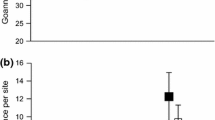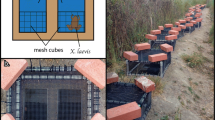Abstract
The invasion of a toxic prey type can differentially affect closely related predator species. In Australia, the invasive Cane Toad (Rhinella marina) kills native anurophagous predators that cannot tolerate the toad’s toxins; but predators that are physiologically resistant (i.e., belong to lineages that entered Australia recently from Asia, where toads of other species are common) have been more resilient. In the current study, we examine the case of an Asian-derived predator lineage that relies on behavioural not physiological adaptations to deal with toads. Despite their Asian origins, Common Tree Snakes (Dendrelaphis punctulatus) are highly sensitive to toad toxins; yet this snake has not declined in abundance due to toads. We exposed captive (field-collected) snakes to toads of different sizes and ontogenetic stages, to quantify feeding responses and outcomes. Tree Snakes were less likely to attack toads than to attack native frogs, and rarely retained their hold on large toads. Tree Snakes ingested frogs of a wide range of body sizes but only ingested very small toads (< 1 g vs. up to 30 g for frogs). Behavioural responses were virtually identical between Tree Snakes from invaded versus yet-to-be-invaded areas, suggesting that preadaptation (from Asia) rather than adaptation (within Australia) is the key to successful utilisation of this novel but potentially toxic prey resource. Nonetheless, a previously-documented shift in relative head sizes of Tree Snakes coincident with toad invasion suggests that the ancestral behavioural tactic may have been reinforced by a recent morphological shift that further reduces maximal prey size, and hence the risk of fatal poisoning.


Similar content being viewed by others
References
Beckmann C, Shine R (2009) Impact of invasive cane toads on Australian birds. Conserv Biol 23:1544–1549
Beckmann C, Crossland MR, Shine R (2011) Responses of Australian wading birds to a novel toxic prey type, the invasive cane toad Rhinella marina. Biol Invasions 13:2925–2934
Bowie JH, Wegener KL, Chia BC, Wabnitz PA, Carver JA, Tyler MJ, Wallace JC (1999) Host defence antibacterial peptides from skin secretions of Australian amphibians. The relationship between structure and activity. Protein Peptide Lett 6:259–270
Cabrera-Guzmán E, Crossland MR, Pearson D, Webb JK, Shine R (2015) Predation on invasive cane toads (Rhinella marina) by native Australian rodents. J Pest Sci 88:143–153
Carroll SP, Loye JE, Dingle H, Mathieson M, Famula TR, Zalucki MP (2005) And the beak shall inherit—evolution in response to invasion. Ecol Lett 8:944–951
Cogger H (2014) Reptiles and amphibians of Australia, 7th edn. CSIRO Publishing, Collingwood
Covacevich J, Archer M (1975) The distribution of the cane toad, Bufo marinus in Australia and its effects on indigenous vertebrates. Mem Qld Mus 17:305–310
Crawley MJ (2012) The R book. Wiley, Chichester
Crossland MR (2000) Direct and indirect effects of the introduced toad Bufo marinus (Anura: Bufonidae) on populations of native anuran larvae in Australia. Ecography 23:283–290
Cunningham DS, Burghardt GM (1999) A comparative study of facial grooming after prey ingestion in colubrid snakes. Ethology 10:913–936
Daly JW, Myers CW, Whittaker N (1987) Further classification of skin alkaloids from neotropical poison frogs (Dendrobatidae), with a general survey of toxic/noxious substances in the Amphibia. Toxicon 25:1023–1095
Doody JS, Green B, Rhind D, Castellano CM, Sims R, Robinson T (2009) Population-level declines in Australian predators caused by an invasive species. Anim Conserv 12:46–53
Doody JS, Castellano CM, Rhind D, Green B (2013) Indirect facilitation of a native mesopredator by an invasive species: are cane toads re-shaping tropical riparian communities? Biol Invasions 15:559–568
Doody JS, Soanes R, Castellano CM, Rhind D, Green B, McHenry C, Clulow S (2015) Invasive toads shift predator–prey densities in animal communities by removing top predators. Ecology 96:2544–2554
Doody JS, Rhind D, Green B, Castellano C, McHenry C, Clulow S (2017) Chronic effects of an invasive species on an animal community. Ecology 98:2093–2101
Erspamer V, Erspamer GF, Mazzanti G, Endean R (1984) Active peptides in the skins of one hundred amphibian species from Australia and Papua New Guinea. Comp Biochem Physiol C 77:99–108
Fearn S, Trembath DF (2010) Natural history of the common tree snake, Dendrelaphis punctulatus (Serpentes: Colubridae), in the wet–dry tropics of north Queensland. Aust J Zool 58:384–389
Feit B, Letnic M (2015) Species level traits determine positive and negative population impacts of invasive cane toads on native squamates. Biodivers Conserv 24:1017–1029
Figueroa A, McKelvy AD, Grismer LL, Bell CD, Lailvaux SP (2016) A species-level phylogeny of extant snakes with description of a new colubrid subfamily and genus. PLoS ONE 11:e0161070
Garton JD, Mushinsky HR (1979) Integumentary toxicity and unpalatability as an antipredator mechanism in the narrow mouthed toad, Gastrophryne carolinensis. Can J Zool 57:1965–1973
Gosner KL (1960) A simplified table for staging anuran embryos and larvae with notes on identification. Herpetologica 16:183–190
Greene HW (1988) Antipredator mechanisms in reptiles. In: Gans C (ed) Biology of the reptilia, vol 16. Alan R. Liss, New York, pp 1–152
Hayes RA, Crossland MR, Hagman M, Capon RJ, Shine R (2009) Ontogenetic variation in the chemical defenses of cane toads (Bufo marinus): toxin profiles and effects on predators. J Chem Ecol 35:391–399
Herzog HA, Bowers BB, Burghardt GM (1992) Development of antipredator responses in snakes: V. Species differences in ontogenetic trajectories. Dev Psychobiol 25:199–211
Kolbe JJ, Glor RE, Schettino LR, Lara AC, Larson A, Losos JB (2004) Genetic variation increases during biological invasion by a Cuban lizard. Nature 431:177–181
Letnic M, Webb JK, Shine R (2008) Invasive cane toads (Bufo marinus) cause mass mortality of freshwater crocodiles (Crocodylus johnstoni) in tropical Australia. Biol Conserv 141:1773–1782
Lever C (2001) The cane toad. The history and ecology of a successful colonist. Westbury Academic and Scientific Publishing, Otley
Llewelyn JS, Phillips BL, Shine R (2009) Sublethal costs associated with the consumption of toxic prey by snakes. Austral Ecol 34:179–184
Llewelyn J, Schwarzkopf L, Alford R, Shine R (2010) Something different for dinner? Responses of a native Australian predator (the keelback snake) to an invasive prey species (the cane toad). Biol Invasions 12:1045–1051
Llewelyn J, Phillips BL, Brown GP, Schwarzkopf L, Alford RA, Shine R (2011) Adaptation or preadaptation: why are keelback snakes (Tropidonophis mairii) less vulnerable to invasive cane toads (Bufo marinus) than are other Australian snakes? Evol Ecol 25:13–24
Llewelyn J, Bell K, Schwarzkopf L, Alford RA, Shine R (2012) Ontogenetic shifts in a prey’s chemical defence influence feeding responses of a snake predator. Oecologia 169:965–973
Llewelyn J, Schwarzkopf L, Phillips BL, Shine R (2014) After the crash: how do predators adjust following the invasion of a novel toxic prey type? Austral Ecol 39:190–197
Minton G, Das I (2012) Chrysopelea paradisi (Garden Flying Snake). Diet. Herpetol Rev 43:144
Mohammadi S, Gompert Z, Gonzalez J, Takeuchi H, Mori A, Savitzky AH (2016) Toxin-resistant isoforms of Na +/K + -ATPase in snakes do not closely track dietary specialization on toads. Proc R Soc B 283:20162111
Nelson DWM, Crossland MR, Shine R (2011) Foraging responses of predators to novel toxic prey: effects of predator learning and relative prey abundance. Oikos 120:152–158
Pearson DJ, Greenlees MJ, Phillips BL, Bedford GS, Brown GP, Thomas J, Shine R (2014) Behavioural responses of reptile predators to invasive cane toads in tropical Australia. Austral Ecol 39:448–454
Phillips BL, Shine R (2004) Adapting to an invasive species: toxic cane toads induce morphological change in Australian snakes. Proc Natl Acad Sci USA 101:17150–17155
Phillips BL, Shine R (2006) An invasive species induces rapid adaptive change in a native predator: cane toads and black snakes in Australia. Proc R Soc B 273:1545–1550
Phillips BL, Brown GP, Shine R (2003) Assessing the potential impact of cane toads on Australian snakes. Conserv Biol 17:1738–1747
Phillips BL, Greenlees MJ, Brown GP, Shine R (2010) Predator behaviour and morphology mediates the impact of an invasive species: cane toads and death adders in Australia. Anim Conserv 13:53–59
Princy JL, Kannan P, Santhosh Kumar P, Samson A (2017) Predation of Raorchestes tinniens by Ahaetulla perroteti in Nilgiris, Tamil Nadu, India. Reptile Rap 169. Zoo’s Print 32:15–18
Reznick D (2016) Hard and soft selection revisited: how evolution by natural selection works in the real world. J Hered 107:3–14
Shine R (1980) Ecology of eastern Australian whipsnakes of the genus Demansia. J Herpetol 14:381–389
Shine R (1991) Strangers in a strange land: ecology of the Australian colubrid snakes. Copeia 1991:120–131
Shine R (2010) The ecological impact of invasive cane toads (Bufo marinus) in Australia. Q Rev Biol 85:253–291
Shine R (2014) A review of ecological interactions between native frogs and invasive cane toads in Australia. Austral Ecol 39:1–16
Shine R, Wang S, Madani G, Armstrong KN, Zhang L, Li Y-M (2016) Using genetic data to predict the vulnerability of a native predator to a toxic invader. Endanger Species Res 31:13–17
Stankowich T, Romero AN (2017) The correlated evolution of antipredator defences and brain size in mammals. Proc R Soc B 284:20161857
Ujvari B, Casewell NR, Sunagar K, Arbuckle K, Wüster W, Lo N, O’Meally D, Beckmann C, King GF, Deplazes E, Madsen T (2015) Widespread convergence in toxin resistance by predictable molecular evolution. Proc Natl Acad Sci USA 112:11911–11916
Urban MC, Phillips BL, Skelly DK, Shine R (2007) The cane toad’s (Chaunus [Bufo] marinus) increasing ability to invade Australia is revealed by a dynamically updated range model. Proc R Soc B 274:1413–1419
Van Rooijen J, Vogel G, Somaweera R (2015) A revised taxonomy of the Australo-Papuan species of the colubrid genus Dendrelaphis (Serpentes: Colubridae). Salamandra 51:33–56
Wells KD (2010) The ecology and behavior of amphibians. University of Chicago Press, Chicago
Wijethunga U, Greenlees M, Shine R (2016) Far from home: responses of an American predator species to an American prey species in a jointly invaded area of Australia. Biol Invasions 18:1645–1652
Wilson S, Swan G (2008) A complete guide to reptiles of Australia, 2nd edn. New Holland Publishers, Sydney
Acknowledgements
We thank Brian West, Ian Eadie, Tanya Ross, Angus McNab, Bill Stewart and Justin Wright for their help collecting snakes, the James Cook University Animal Ethics Committee, and the University of Sydney Animal Care and Ethics Committee for approving all procedures.
Funding
This project was funded by the Australian Research Council (FF0561365).
Author information
Authors and Affiliations
Corresponding author
Ethics declarations
Conflict of interest
The authors declare that they have no conflict of interest.
Rights and permissions
About this article
Cite this article
Llewelyn, J., Choyce, N.C., Phillips, B.L. et al. Behavioural responses of an Australian colubrid snake (Dendrelaphis punctulatus) to a novel toxic prey item (the Cane Toad Rhinella marina). Biol Invasions 20, 2507–2516 (2018). https://doi.org/10.1007/s10530-018-1716-1
Received:
Accepted:
Published:
Issue Date:
DOI: https://doi.org/10.1007/s10530-018-1716-1




